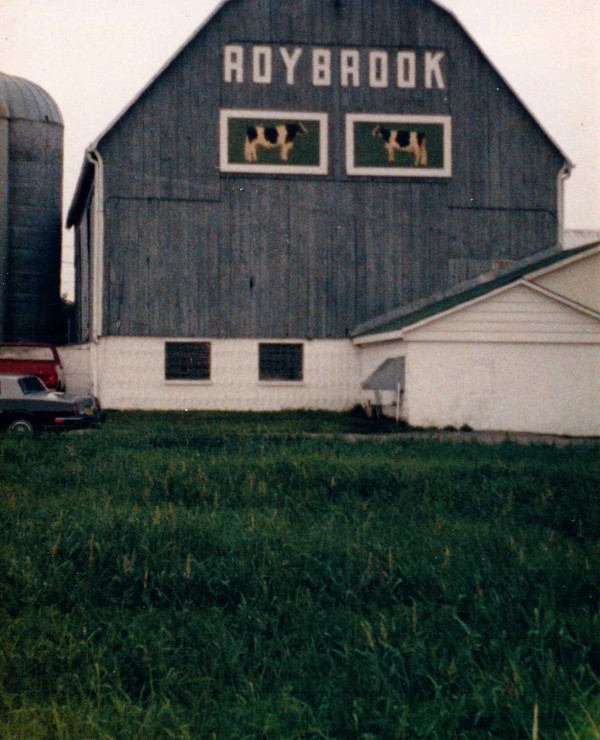Legendary Holstein breeder Roy Ormiston celebrates his 100th Birthday in a few weeks hence. Bruce Jobson and Roy recount the legacy of Roybrook in an exclusive interview. In this unique conversation, Bruce included some additional datelines for reader clarity and understanding.
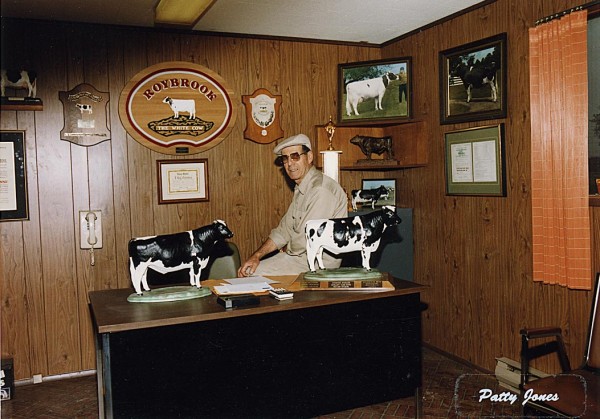
Roy Ormiston, of Robrook fame, will celebrate his 100th Birthday in February. Photo Patty Jones
There are very few cattle breeders held in the same esteem as Roy Ormiston. He is one of an elite group globally known by a single name; “Roy” (Roybrook) “Wally” (Linskoog: Arlinda) “Pete” (Heffering: Hanoverhill) and in the UK “Moff” (John Moffitt: Hunday) As time has marched forward; only Roy remains with us from what is considered the halcyon era of cattle breeding.
The story really began 70 years ago; when Roy, a young Holstein breeder, joined the Canadian Holstein Association as an Ontario fieldman in 1944; where he worked for seven years as extension officer, including some classifying duties. He had already started farming at 21, taking over his father’s farm (Ormsdale) at Brooklin, Ontario and owning five cows. He later farmed with his brother before establishing his own Roybrook prefix.
BJ “Roy, you purchased a cow bred by Ben Brown, of Bowmanville, Ontario; Balsam Brae Pluto Sovereign Ex. This animal became universally known as “the white cow. How did you find her?
Roy: “I heard about this “white cow” and decided to visit Ben and first saw her as a Very Good five-year-old in 1956. I really liked the look of this cow, despite her being dry; and her age. Ben had turned down $700 that morning from a US dealer; I made an offer of $700, but she had not been on “test” recording and we did not known what her butterfat percent would be – so I offered another $50 bonus – provided she tested at 3.6% or higher.
“The offer was accepted and after she calved-out, Sovereign, known as “the white cow” was judged winner of the All Aged Cow Class at the Royal Winter Fair in Toronto and also Best Uddered Cow. She had come from nowhere to win the most prestigious of shows. Albert Seiling of Seiling Holsteins offered $10,000 – a large sum of money at the time – but I refused to sell.”
BJ “There are many people who consider you as the greatest exponent of “line-breeding” owing to the success of the Roybrook bloodlines. Some consider line-breeding; when it does not work is, “inbreeding.” You are the man – what is your take on the subject?”
Roy: “It was line-breeding – not inbreeding. We never inbred. But I owned a remarkable cow family and wanted to capitalise on these immense qualities. It’s a case of wanting to increase or intensify the best traits or qualities such as size and strength. Inbreeding can result in lack of size and strength and vigour. The white cow was strong, more than the average cow – she was dominant and “controlled” the matings.
“Two of her daughters were Roybrook Model Lady and Royal Delight, and both scored Excellent. The latter cow produced the most famous daughter; Roybrook Model Lass Ex, she was bred from Roybrook Ace, a son of the white cow, from a mating to Lakefield Fond Hope.
“We therefore had the white cow as the bull dam on the top side, and the third dam on the bottom line. The resulting bull calf was Telstar, (born December 1963) Telstar was sold at the National Holstein Sale in the following May to the Telstar Syndicate for $25,000. A few weeks later, having sold the bull, I bought into the syndicate.”
BJ “The bull was named after the world’s first satellite, Telstar; which was launched on July 10th, 1962; the date is recognised as the day that “information went global.” Roybrook Telstar arguably did the same in the bovine world; as the first global Holstein superstar?”
Roy “He certainly had an impact in Canada and Japan. Cattle photographer, Jim Rose, suggested the name. The syndicate sold Telstar to Japan in June 1967; his Canadian progeny were outstanding and all the talk was about Telstar. His daughters were show winners, became brood cows and outstanding bullmothers. Due to widespread AI, and export of progeny, his proofs and influence became global.
“Telstar was designated as a Class Extra sire (in 1971, Canada’s highest accolade on the basis of simultaneous improvements in type and production) In Japan, he was equally admired and in 1978, I was privileged to unveil a bronze statue of Telstar at the All-Hokkaido Show; at the opening of the Dairy Shrine.”
BJ “OK, Telstar paved the way for another bull that arguably had an even greater global impact; Roybrook Starlite. As you stated, the bull was line-bred and only carried 0.93 inbreeding levels. Roy, what was the thinking on that mating?”
Roy “Seiling Rockman was known as the “Genetic Giant” and his daughters had prolific milk production. Starlite was a mating that truly encompassed the best traits of his sire and his dam. For many years the Canadian production Honour List was dominated by Rockman, his son, Starlite and Starlite’s maternal brother, Telstar. Therefore, Rockman was a very powerful mating.
BJ “I will just mention; the University of Guelph Top Transmitter List contained the top 600 cows throughout Canada. When Starlite died (in 1981) 376 cows ranked on this list were from Ontario – and 103 were Starlite daughters; almost 30% of the top cows in Ontario were related to Starlite.
“Starlite semen was exported all over the world. In 1982, three Starlite daughters at Mowry Farms, Pennsylvania, were rated in the top three positions in the USDA Cow Index. At that time, the chances of one daughter being the No.1 cow USDA milk and butterfat producer were rated above 8 million: 1. In fact, Starlite had the top three USDA cows – all bred in one herd.
“The bull came to prominence in the UK when 25 Starlite heifers were imported into the UK by the late Harold Nicholson, herd manager for Sam Noble, owner of the Deehaven Herd in Cheshire. The Starlite daughters were an outstanding success. His global influence was immense as well as, through his sons. Roy, I now want to move on to the next era and will you explain the mating of the third Roybrook superstar; Tempo?”
Roy “I judged the Ontario Show and first two-year-old was Briarwood Melissa. She was an immense Telstar daughter; almost twice the size of others, she had such power and strength. After the show, I went to the barn and asked if she was for sale and they wanted $25,000. I said I wanted to buy the cow; not the farm.
“She was subsequently shown and won at Toronto; and I purchased her at The Sale of The Stars for $14,000. The next day, I went to the bank to borrow the money. Melissa was bred to Starlite; therefore “the white cow” influence was close-up on both sides of pedigree. Tempo had a type proof with the qualities of both bulls.”
BJ “Roy, I will interject, Tempo was born in 1973 and like Telstar and Starlite, he was awarded Class Extra Sire status. Tempo had over 15,000 Canadian scored daughters (29,000 in total) and averaged 70% Good Plus and Better on classification. His sire, Starlite had over 8,000 scored daughters (13,000) that averaged 55%.
“His maternal-sire, Telstar, had 611 Canadian daughters (863) that averaged 86% Good Plus. Tempo came out with an identical average of 70% Good Plus and Better; the exact “mean average” figure between the proofs of both Starlite and Telstar. Tempo – bred “true.” The legacy was a remarkable achievement, all line-bred from a single cow family, housed in a traditional 30 stall Canadian barn. So, which of the three bulls is your favourite?”
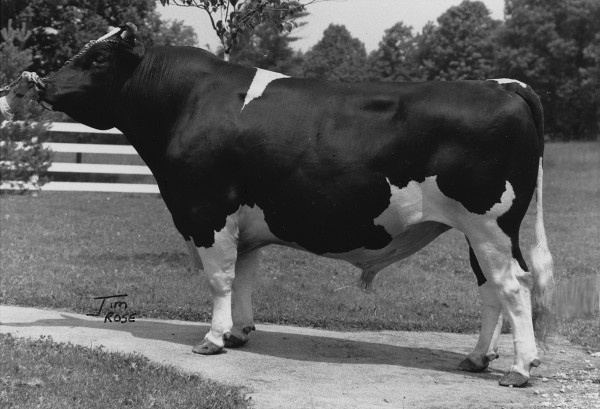
Roybrook Telster
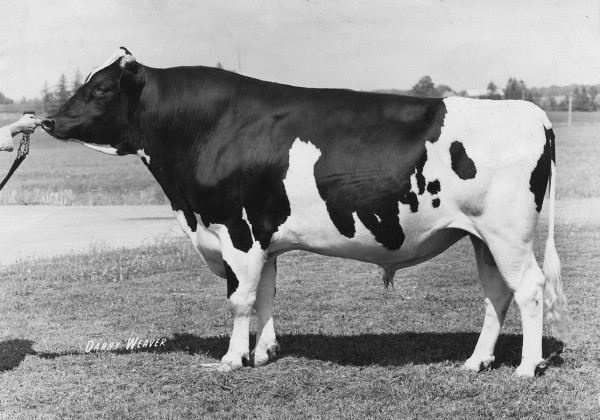
Roybrook Starlite
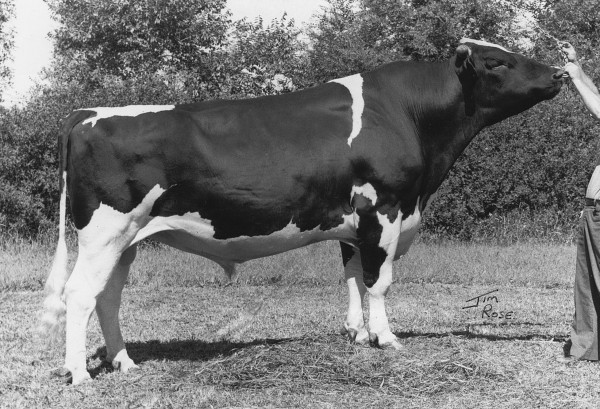
Roy brook Tempo
Roy “I do not have a favourite. All three bulls achieved Class Extra status and all three were different and each bull transmitted different things. Starlite daughters transmitted higher levels of production and were slower to mature as two-year olds – and therefore did not classify as high.
BJ “Roy, 40 years ago you said “Life is too short to start with poor stock.” You are now approaching 100 years old, what advice would you give to someone starting out today?”
Roy “That is still true. Start with the best you can afford. But it is extremely hard for any young person to get involved in farming today. It is even harder in Canada owing to having to buy milk quota, the farm and cows. Everything is bigger and unless your parents are involved or are extremely wealthy, it is almost impossible to get started in dairying.
“Today, many farms have 200, 400 cows or more. That takes a lot of funding with Canadian milk quota at around $25,000 per cow. We kicked the trend even back in the 70s and 80s, we were a small 30-odd cow dairy and the farm was 100 acres; yet I sold cattle to every continent on the globe.
“Things were rapidly changing in the late 80s, with bigger commercial herds and several high profile pedigree breeder herds; (Comstar, Dupasquier, Gillette) these were exciting times; great days, and I remember sitting next to your wife, Helen, at the 1987 Hanoverhill Sale. I sold the Roybrook herd in 1990 – I was getting on in years although, I had a few cows around the farm for another 12 months.
BJ “With all the indices, sexed semen, ET and genomic information available, is it easier to be a breeder in 2014, than in 1944?”
Roy “Bruce, there is more information available today – and maybe there is too much information. It was easier in the past; and breeding goals have changed. We now have genomics and this has changed the bull breeding game and the industry. I have concerns about the level of inbreeding and the possibility of losing, size, capacity, vigour and strength.
“We are also asking two-year-old heifers to produce 120lbs of milk or 50litres per day; and I wonder how long these young cows will last? I still believe in the value of cow families, longevity and a common-sense approach to cattle breeding. Today, everything is faster; everything is bigger.”
BJ “Roy, besides your influence within the global cattle breeding industry, you have, and will continue to have, a strong influence within the local community. How did that happen?”
Roy “Well, I believe in putting back into the local community and since the sale, have done that. I sold land for development and have made donations to local charities. Brooklin has now expanded over the farm and the barn has made way for a new highway. The streets are named in our honour such as Roybrook Avenue, Telstar Avenue, Tempo and Delight.
“I still live on my own, in a bungalow built on the farm – and keep myself busy and active. I have donated 25 acres of land and $2million in order to build a new hospital. It’s something I want to do for the local community; one that I was brought up amongst, and where I have lived my whole life. That will be a true and lasting, Roybrook legacy.”
This article first appear in the December 2014-February 2015 Edition of Crazy Cow in Print. Click here to check out there Facebook group and watch for their new website soon.







